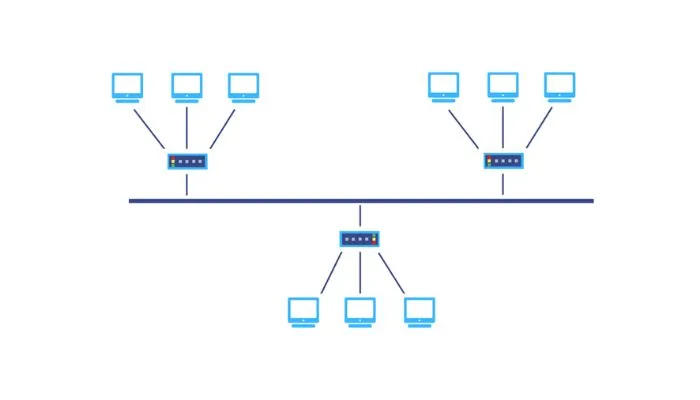Table of Contents
What is Tree Topology?
Tree topology, also referred to as hierarchical topology, is a network structure where each node is interconnected in a hierarchical manner, resembling the branches of a tree. This article delves into the depths of tree topology, its applications, advantages, and disadvantages, shedding light on this essential networking concept.
Components
To grasp the concept better, let’s break down the key components of a tree topology:
- Root Node: At the top of the hierarchy, we have the root node. This node serves as the central point from which all other nodes branch out. Think of it as the “trunk” of our network tree.
- Branches: From the root node, branches extend outward, connecting to intermediary nodes. These branches are analogous to the main branches of a tree.
- Leaf Nodes: At the end of each branch, we find the leaf nodes. These nodes represent the end-users or devices in the network, such as computers, printers, or other peripherals.

How does Tree Topology work
In a tree topology, every node is connected to a central node in a hierarchical fashion. Each secondary node maintains a point-to-point link with its parent node, while all secondary nodes under its purview have similar point-to-point connections with tertiary nodes. This structure, when visualized, closely resembles a tree, hence the name.
Types of Tree Topology
- Bus Tree Topology: Central devices like hubs or switches connect PCs to a backbone cable.
- Cluster Tree Topology: Emphasizes parent-child connections between nodes.
- Spanning Tree Topology: Connects all nodes of a graph, including minimal spanning tree (MST) concepts.
Advantages of Tree Topology
- Scalability and Flexibility: Tree topology offers scalability without the need to puncture the main backbone cable. New devices can be added easily by expanding the star network at each branch, creating more space through a star network.
- Fault Tolerance: If one or more nodes fail, the network remains operational. Even if a single switch or hub is damaged, the network can continue functioning.
- Ease of Management: Managing and maintaining a tree topology network is relatively straightforward.
- Node Expansion: Expanding nodes is swift and uncomplicated.
- Error Detection: Tree topology simplifies error detection.
- Enhanced Performance: Utilizing intelligent hubs or switches, tree topology offers superior performance compared to bus networks.
- Suitable for Small-Sized LANs: Ideal for small-sized organizations, tree topology provides reliable connectivity.
Disadvantages of Tree Topology
- Dependency on Main Bus Cable: Tree topology relies on a cable to transmit data across the network. If the main bus cable fails, it can disrupt the entire network.
- Complex Maintenance: Maintaining a network with multiple nodes and trees can be challenging, particularly when scalability is pushed to its limits.
- 5-4-3 Rule: Tree topology networks often follow the 5-4-3 rule, which can limit network expansion.
- Cable Type and Length Limitations: The choice of cable type and length can impact the scalability of the network.
- Installation Complexity: Setting up a tree topology network can be intricate and costly.
- Security Concerns: All workstations in a tree topology network have access to sent data, making it potentially less secure.
- Equipment Costs: Tree topology combines bus and star topologies, leading to higher equipment costs.
- Terminator Sensitivity: Terminators in tree topology networks require careful handling.
- Not Suitable for Large Enterprises: Due to its limitations, tree topology may not be suitable for large enterprises.
Applications and Uses
The utility of tree topology depends on user needs and preferences. It finds relevance in scenarios such as:
- Multi-story buildings require network clusters on each floor.
- Organizations with departments and sub-departments.
- Utilizing Zigbee-like networks for specific purposes.
Comparing Tree Topology with Other Network Topologies
Let’s compare Tree Topology with some other common network topologies:
- Star Topology: Tree Topology shares similarities with Star Topology but offers better scalability.
- Bus Topology: It combines aspects of Bus Topology but provides greater fault tolerance.
Tree topology is a fundamental concept in networking, offering both advantages and disadvantages. Its scalability, fault tolerance, and ease of management make it a viable choice for various scenarios. However, it comes with limitations and complexities that must be considered when designing a network. Understanding the nuances of tree topology is crucial for making informed networking decisions.
By adhering to these guidelines and providing comprehensive insights, this article aims to empower readers with the knowledge needed to navigate the intricate world of tree topology in computer networks.


